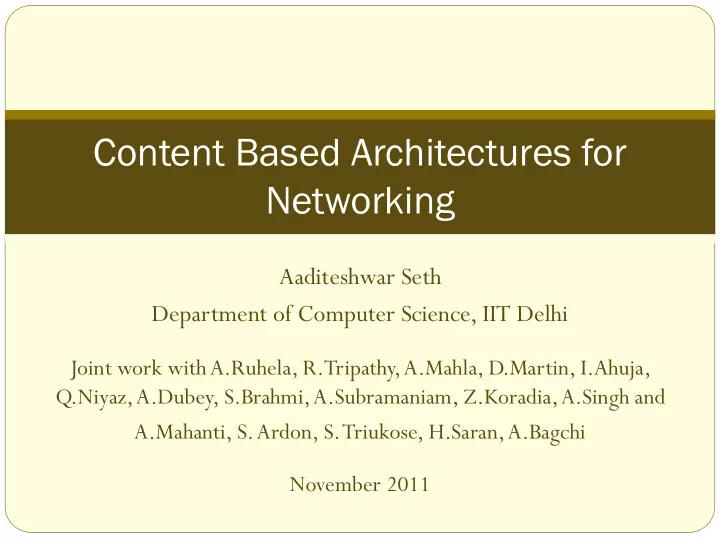

Content Based Architectures for Networking Aaditeshwar Seth Department of Computer Science, IIT Delhi Joint work with A.Ruhela, R.Tripathy, A.Mahla, D.Martin, I.Ahuja, Q.Niyaz, A.Dubey, S.Brahmi, A.Subramaniam, Z.Koradia, A.Singh and A.Mahanti, S. Ardon, S. Triukose, H.Saran, A.Bagchi November 2011
Gen 1: Phone numbers carry path information 2
Gen 2: Endpoints have addresses, nodes switch packets [Baran, 1964]
Today
Internet ~ Content transfer Cisco, 2009 Moon, et al, IMC 2007 5
Content delivery networks, flattening Internet Internet Atlas, NANOG, 2009 6
Content sharing via social networking websites Pew Internet, 2008
Gen 3: Semantic content based networks Users care about content, not where it is available Treat content objects as first class entities in the network Push/pull content objects Content lookup servers Routers can cache content Semantic cache replacement, pre-fetching policies Utilize content metadata Utilize OSN signals about content metadata 8
OSN aided content distribution
Network architectures a. CDN guided by data from online social networking websites b. P2P gossip on social network overlay 10
Dataset 7M users 196M tweets Duration: June 11, 2009 to Sept 1, 2009 OpenCalais to identify tweet topics 6M topics, reduced to 0.9M topics having at least 15 users Sampled 4K topics for detailed analysis Yahoo geocoding API to identify user locations 4M users with locations 11
Topic spread across geographies • Can use traffic spikes in originating region to predict spikes in other regions • LDA for topic identification, CF and follower-count for country similarity 12
Popular topics have a large spread, unpopular topics confined to few countries • High degree of spatial locality can be useful for content placement and caching • Explore at city/region level too 13
Does initiator popularity predict topic popularity? 14
Tracking giant component growth can help • Dominant giant component in popular topics, not as dominant in less popular topics • But growth of giant component seems to always coincides with popularity growth. Methods to track giant component growth dynamically? 15
Other interesting observations Periodic topics Ephemeral Vs stable Sharp/slow growth and decay 16
Next steps Online event detection algorithms Predictors for geographic spread of topics Simulations to evaluate CDN Vs. P2P content distribution architectures Cache replacement policies Pre-fetching Centralized and distributed algorithms 17
Content based networks for rural areas
Community media in rural areas Variety of mechanisms Community radio Community video Wall newspapers … 19
• Digital Green: 1500+ videos (5 states) • Community radio: 5GB new content per month • Rural news: 40,000+ calls per month per state
Ideas and awareness for creating relevant programs Topic of the month • Employment • Right to Food • Water and sanitation • Maternal and child health Produce impactful programs • Civic activism • Political change 21
Social networking and content sharing 22
Digital Green dataset analysis
A content distribution network for rural areas Constraints Design principles Application use-cases: Publish-subscribe, broadcast, multicast, browsing and content download Content-based network. Content objects are Local content production and consumption. first class entities; routers can cache content, Metadata can reveal access patterns examine metadata Content transfer capabilities to/from local rendezvous points in villages Applications are tolerant of delays Delay tolerant data transfer. Always-on content channel for route initializations and 2G coverage is not sufficient for large content 24 content download/upload requests transfers. But ubiquitously available now
Network stack 25
Simulation analysis Topology layout Block-block, block-district roads Villages clustered around blocks Village-village, village-block Movement schedules Village-block by ad hoc means of transport. Once a day Block-block, block to district, by bus. Few times a day Algorithms Unicast with caching, multicast, multicast with pre-fetching, optimal multicast Cache replacement: LRU, seasonal preference 26
Download requirements at gateway 27
Effects of network topology Short circuiting across villages helps in mesh-like topologies
Effects of consumption patterns Not much improvement with seasonal preference according to indicated relevance periods DG screens videos throughout the year to sustain community interest Not much improvement with cache sizes beyond 1GB DG makes rounds of villages screening the same set of videos, then moves on to other videos Next steps More rigorous analysis of cache occupancy Dataset and topology modeling to design generic policies Small-scale field deployment 29
Application framework for mobile devices with flaky Internet connections
Mobile traffic Cisco, 2011 31
App server Telcos are already putting caching proxies in their access networks
Offline application development Applications run offline from a local cache Key-value get/put API to data-store Data-store synchronization provided by the middleware itself Optimized transport layer Control-data separation Other features Data summarization Namespace subscriptions Security & access control Transactions Consistency 33 Middleware
Evidence of traffic shaping in cellular data networks? Download on GPRS 34
Or, aggregate slot allocation on uplink? Ack bunching at server trace Client trace is clean however Download on GPRS 35
Non-uniform latencies on uplink 300ms 800ms 200ms 700ms 150ms Upload on GPRS 36
Next steps Model traffic shaping and scheduling policies used in different cellular data networks Optimize TCP for these conditions Release application development framework for Android Collect user data on WiFi mobility and content access patterns to determine delivery latencies and usability insights 37
Key messages Content based network architectures can improve performance in today’s Internet usage context Semantic metadata Social networking websites Challenges present themselves at different layers Architecture appropriateness Prediction algorithms for pre-fetching Tracking algorithms for event detection Application development framework Optimized transport layers Thanks for listening!
39
Spread occurs to countries with followers in that country LDA for topic identification, CF and follower-count for recommendation on country similarity 40
Recommend
More recommend